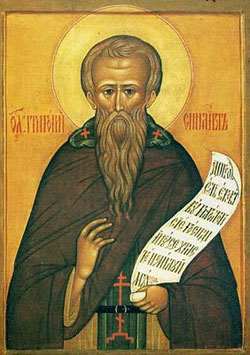
Born near the end of the XIII Century, St. Gregory was a native of Asia Minor. The Turks captured him when he was a young man, and after he was ransomed, he travelled to Cyprus, where he became a rasophore. He was professed a monk at Sinai and became on Crete a disciple of Arsenios, from whom he learned the practice of the Jesus prayer. Gregory was also influenced by Sts. John Climacus and Symeon the New Theologian. Around the turn of the century, he moved to Mount Athos, to the Magoula skete near Philotheou monastery. He and his contemporary Gregory Palamas helped to establish Athos as a center of hesychasm. When the Turks began to raid Athos c. 1325/1328, Gregory sought refuge in Bulgaria, where he established a monastery at Paroria in the Stranozka mountains. Gregory, who died in 1346, returned briefly to Athos in the 1330's but seems not to have participated in the debates about hesychasm. Gregory sees prayer as a continuation of the work of the Holy Spirit that was begun in baptism. He follows the teaching of the Fathers about knowledge: prayer purifies the mind. The intellect then sees and understands in the depth of love.
| This article includes a list of references, related reading or external links, but its sources remain unclear because it lacks inline citations. (October 2019) |
Gregory of Sinai or in Serbian and Bulgarian Grigorije Sinaita (around 1260s – 27 November 1346) was instrumental in the emergence of Hesychasm on Athos in the early 14th century.
Born in Smyrna, he was captured by Seljuk Turks as a young man, and eventually ransomed to Cyprus, where he became a monk at Saint Catherine's Monastery. Later, he moved to Crete, where he learned the practices of Hesychasm from a monk named Arsenios, and in 1310 he went to Mount Athos, where he remained until 1335. Increasing Muslim raids on Athos pushed Gregory and some disciples into the Bulgarian Empire, where he would find protection under Bulgarian Emperor Ivan Alexander and where he founded a monastery near Paroria, Strandzha mountains in southeast Bulgaria.
The Philokalia includes five works in Greek by Gregory,
- On Commandments and Doctrines, Warnings and Promises; on Thoughts, Passions, and Virtues, and also on Stillness and Prayer: 137 Texts
- Further Texts
- On the Signs of Grace and Delusion, Written for the Confessor Longinos: Ten Texts
- On Stillness: Fifteen Texts
- On Prayer: Seven Texts

